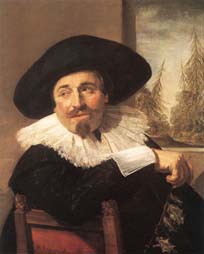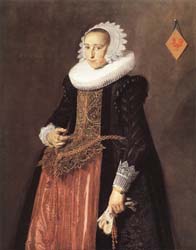Art Home | ARTH Courses | ARTH 200 Assignments
Constructing Female Artistic Identity in the Seventeenth Century
We have seen how male artists in the seventeenth century used self-portraits to construct their identities. In his Las Meninas, Velazquez with all his representational skills asserted his claim as a court artist and the importance of painting. Rembrandt in his series of self portraits can be seen to be exploring a variety of different identities. In these images the artists employed the language and conventions of art to fashion their identities. From the seventeenth century we have an increasing number of known examples of women who had careers as artists. Self portraits became a way for women artists to articulate their identities as artists. Two notable examples are Artemisia Gentileschi's Self Portrait as the Allegory of Painting and Judith Leyster's Self Portrait (c. 1635)
Artemisia Gentileschi's Self-Portrait as the Allegory of Painting is an incredibly bold work for it's time. Painted during the Italian Baroque period in approximately 1630, and using elements of the "Allegory of Painting" from author Cesare Ripa's 1611 Iconologia, Gentileschi took an incredibly egotistical stand- to say that she was not only a female painter at a time when women were not even admitted into the artistic academies- but that as a female painter, she is the very embodiment of painting itself. Her posturing in the piece, with her raised chin, and the dynamics of showing herself deeply focused on the act of painting, also convey a sense of pride- and in addition to that, underscore the idea that she is an artist at work, showing herself in the pursuit of the noble goal of fulfillment, of personal achievement and happiness through her own means.
An interesting note is that Gentileschi followed the allegorical references
for the "Allegory of Painting", according to Ripa, except for one.
The symbols of the allegory are:
- A pendant mask on a gold chain, showing the artist's capability for imitation
of what they see in life.
- A color changing dress (difficult to see in digital representations of this
work, but the green dress she has depicted herself in shifts colors in it's
folds and highlights very subtly)- another interesting side note here would
be that the "Allegory of Art", according to Ripa, is to be depicted
in green, thus tying together painting as part of art as a whole.
- Unruly hair, depicting "the divine frenzy of the artistic temperment",
or showing the artistic conveyance of depicting work with emotion and inspiration.
- The tools of a painter (palette and brush), shown in this piece being used
and handled directly by the artist, while in many typical allegorical pictures
from the time, they were placed nearby the figure, but not in use.
- A piece of cloth binding the mouth of the allegory, meant to symbolize the
non-verbal means of expression that the painter is limited to.
This is the part that Gentileschi left out, which leads me to think that this
could have been a mark of refusing to be "kept quiet" or "stay
in her place" as a woman at the time, but instead to be bold and proud-
neither qualities which were particularly promoted in women at the time.
About 1635, Judith Leyster painted this self portrait. Leyster was born in Haarlem in 1609. She was the eighth child of a brewer and clothmaker. In 1628 her family moved to a town near Utrecht. At that moment, Utrecht was the active center of a group of artists working in the tradition of Caravaggio. The work of these artists including Hendrick Terbruggen and Honthorst had a significant impact on Leyster's work. In 1629 Leyster and her family returned to Haarlem. By 1633 she became one of only two women to be granted membership to Haarlem's Guild of St. Luke. Within two years, Leyster had taken on three male apprentices in her shop. There are records of a suit initiated by Leyster claiming that Frans Hals had stolen one of her apprentices. All of this indicates that Leyster during the early 1630's ran an active workshop. It is from this period that the majority of her works are attributed. In 1636, she married a fellow painter, Jan Meinse Molenaer (1610-1668). The couple moved to Amsterdam. Her artistic production drops off dramatically at this point. Is it because she took on the traditional responsibilities of the wife working in the husband's shop and caring for their five children?
 The self-portrait now in the National Gallery of Art in Washington D.C. places Leyster's work in the dominant currents of Dutch art of the period and constructs Leyster's identity as an artist. The painting was perhaps Leyster's "masterpiece" submitted to support her admission to the Guild of St. Luke. Leyster represents herself in the fashionable dress of the Dutch middle class. This is hardly the simple smock one might expect the artist to wear in the workshop, but rather it is the dress that signifies her social and economic status. The relationship of Leyster's work to that of Frans Hals, the dominant Haarlem artist of the period, has not been fully clarified. It has been suggested that she was an apprentice in Hals' shop, but this is not certain. The similarity of Leyster's work to that of Hals led early scholars to attribute her work to Hals. Leyster's self-portrait unmistakably relates her work to that of Hals.
The self-portrait now in the National Gallery of Art in Washington D.C. places Leyster's work in the dominant currents of Dutch art of the period and constructs Leyster's identity as an artist. The painting was perhaps Leyster's "masterpiece" submitted to support her admission to the Guild of St. Luke. Leyster represents herself in the fashionable dress of the Dutch middle class. This is hardly the simple smock one might expect the artist to wear in the workshop, but rather it is the dress that signifies her social and economic status. The relationship of Leyster's work to that of Frans Hals, the dominant Haarlem artist of the period, has not been fully clarified. It has been suggested that she was an apprentice in Hals' shop, but this is not certain. The similarity of Leyster's work to that of Hals led early scholars to attribute her work to Hals. Leyster's self-portrait unmistakably relates her work to that of Hals.  The informality of the pose with her turning away from her easel to look out at the viewer with her right arm resting on a chair back and jutting out towards a viewer is a portrait convention made popular by Frans Hals (see examples included on the linked image list). The 1626 portrait of Isaac Abrahamsz Massa gives an early example of this portrait type. Spontaneity and informality are characteristics of the convention which gives the sitter a sense of active engagement with the viewer's world. The web of diagonals that Hals uses to animate the composition are echoed in the Leyster composition. What is significant is that Hals uses this convention in the representation of male figures and notably not in the representation of women. Whereas the men with their jutting elbows actively challenge the boundary between the viewer's world and the pictured world, the women in the Hals' portraits are more contained in the picture space. The women's gestures enclose the figure regularly in Hals' portraits. The 1625 portrait of Anetta Hanemans illustrates this characteristic of the female portraits.
The informality of the pose with her turning away from her easel to look out at the viewer with her right arm resting on a chair back and jutting out towards a viewer is a portrait convention made popular by Frans Hals (see examples included on the linked image list). The 1626 portrait of Isaac Abrahamsz Massa gives an early example of this portrait type. Spontaneity and informality are characteristics of the convention which gives the sitter a sense of active engagement with the viewer's world. The web of diagonals that Hals uses to animate the composition are echoed in the Leyster composition. What is significant is that Hals uses this convention in the representation of male figures and notably not in the representation of women. Whereas the men with their jutting elbows actively challenge the boundary between the viewer's world and the pictured world, the women in the Hals' portraits are more contained in the picture space. The women's gestures enclose the figure regularly in Hals' portraits. The 1625 portrait of Anetta Hanemans illustrates this characteristic of the female portraits.
The painting on the easel serves to advertise a particular commodity that Leyster's workshop markets as well as places Leyster's work in the context of Dutch art. The image of the musician appears in another Leyster painting entitled The Merry Trio. The jolly musician was a popular subject among the Utrecht Caravaggisti. Hendrick Terbrughen's painting entitled Duet exemplifies this type of work. Frans Hals who was strongly influenced by Terbrughen painted a number of paintings of this subject matter.
Consider a comparison of the Judith Leyster Self-Portrait and the Sofonisba Anguisola, Self-Portrait:
Consider a comparison between Judith Leyster's Self-Portrait and Rembrandt's "Kenwood" Self-Portrait:
Note how in Leyster's self-portrait, she clearly places her within the tradition of Dutch painting, while Rembrandt emphasizes his uniqueness.
| As exemplified by the painting by Dirck van Baburen, paintings of propositions, prostitution, and brothels were popular in seventeenth century Dutch painting. Leyster's The Proposition is her take on this subject matter. | |